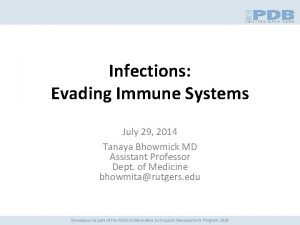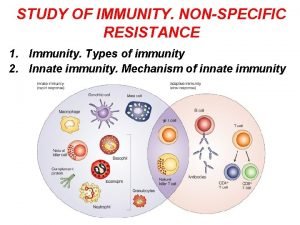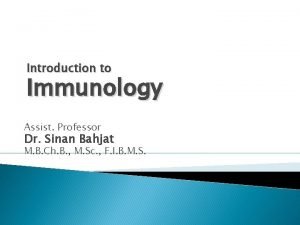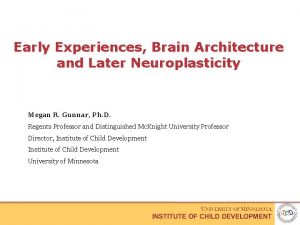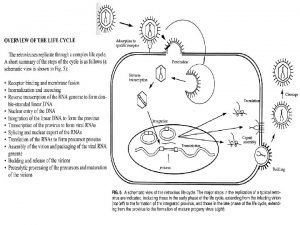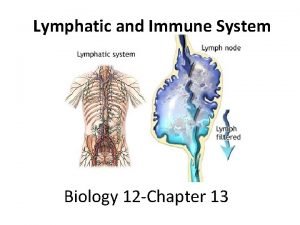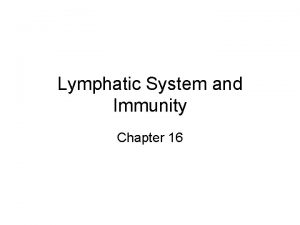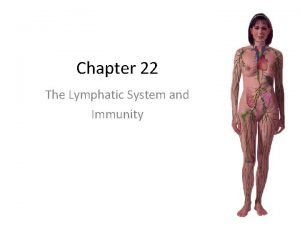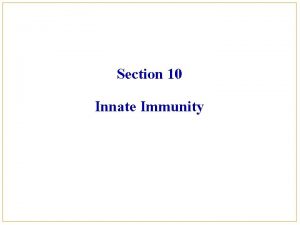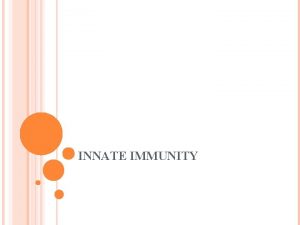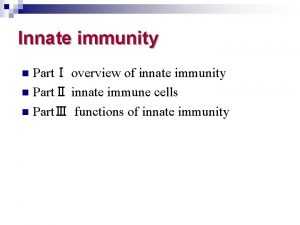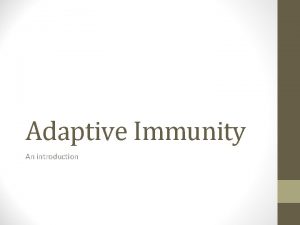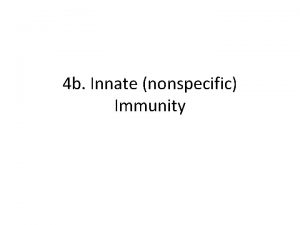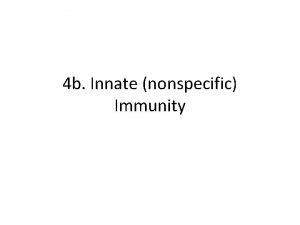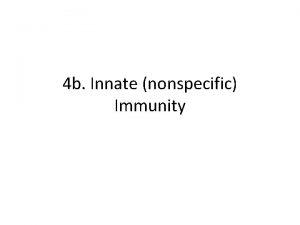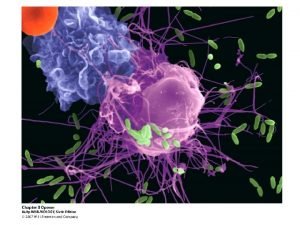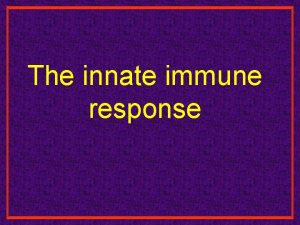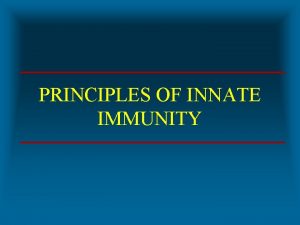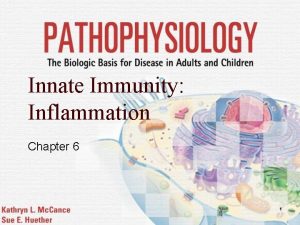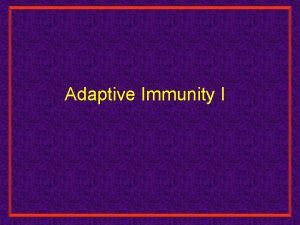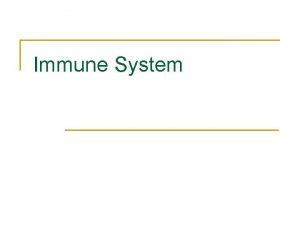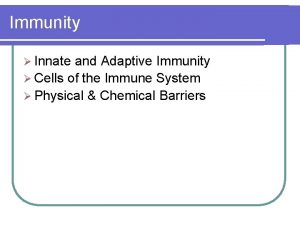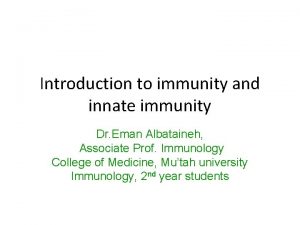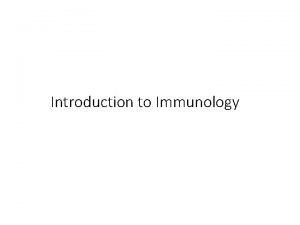Chapter 4 Innate Immunity Innate immunity is the










































- Slides: 42

Chapter 4 Innate Immunity


• Innate immunity is the initial response to microbes that prevents, controls, or eliminates infection of the host • Inhibiting or eliminating of innate immunity markedly increases susceptibility to infections, even when the adaptive immune system is intact and functional • Innate immunity to microbes stimulates adaptive immune responses and can influence the nature of the adaptive responses to make them optimally effective against different types of microbes • Innate immunity not only serves defensive functions early after infection but also provides the "warning" that an infection is present

Innate Immune Recognition • Components of innate immunity recognize structures that are characteristic of microbial pathogens and are not present on mammalian cells: – Pathogen-associated molecular patterns (PAMPs) include LPS, N-formyl met. , Cp. G – The innate immune system also recognizes endogenous molecules that are produced by or released from damaged and dying cells. These substances are called damage associated molecular patterns (DAMPs) – Pattern recognition receptors (PRR) • Innate immune system recognizes microbial products that are often essential for survival of the microbes such as ds-viral RNA, LPS, Cp. G-DNA, Nformylmethionine • Pattern recognition molecules of the innate immune system include cellassociated pattern recognition receptors expressed on the surface of or inside various cell types, and soluble proteins in the blood and extracellular fluids

• Because of this specificity for microbial structures, innate immune system is able to distinguish self from nonself, but it does so very differently from the adaptive immune system • PRR of innate immune system are encoded in germline DNA with low diversity 103 molecular patterns capable of 107 in adaptive immune system

Specificity of Innate and Adaptive Immunity

PAMPs and DAMPs

Pattern Recognition Molecules of the Innate Immune System



Structure, location, and specificities of mammalian TLRs

Signaling Functions of TLRs

The Inflammasome - Cryopyrin Associated Periodic Syndromes (CAPS) - Autoinflammatory syndromes

Components of Innate Immunity

Epithelial Barriers • Intact epithelial surfaces form physical barriers between microbes in the external environment and host tissue • Three main interfaces between the environment and the host are the skin and the mucosal surfaces of the gastrointestinal (GI) and respiratory tracts • Peptides that have antimicrobial properties (Defensins and Cathelicidins)

• Defensins (secretory): – Paneth cell defensins (major source) are sometimes called crypticidins, in small bowel – protective actions include: direct toxicity to microbes, and the activation of cells involved in the inflammatory response to microbes • Cathelicidins (membranous): – expressed by neutrophils and various barrier epithelia – proteolytically cleaved into two peptides – direct toxicity to a broad range of microorganisms, and the activation of various responses in leukocytes

Epithelial Barriers • Barrier epithelia and serosal cavities contain certain types of lymphocytes, including intraepithelial T lymphocytes and B-1 subset of B cells, respectively, which recognize and respond to commonly encountered microbes • Very little diversity • Recognize structures commonly expressed by many different or commonly encountered microbial species (PAMPs) • Perform similar effector functions as do other lymphocytes and with antigen receptors like other T or B cells • More to effector cells of innate immunity than adaptive immunity

Epithelial Barriers • Intraepithelial lymphocytes: – are distinguished mainly by the type of T cell antigen receptors (conventional αβ, γδ TCRs) – TCRs recognize peptide and non peptide antigens – function in host defense by secreting cytokines, activating phagocytes, and killing infected cells • B-1 cells: – produce Ig. M specific for polysaccharide and lipid antigens – natural antibodies are produce largely by them • A third population of cells mast cells: – respond directly to microbial products by secreting cytokines and lipid mediators that promote inflammation

Phagocytes and Inflammatory Responses • Phagocytes, including neutrophils and macrophages, are cells whose primary function is to identify, ingest, and destroy microbes • Neutrophils ü ü ü ü polymorphonuclear leukocytes (PMN), nucleus with three to five connected lobules most abundant population of circulating WBC 12 to 15µm The cytoplasm contains granules of two types, specific granules (enzyme such as lysozyme, collagenase, and elastase) that do not stain strongly with either basic or acidic dyes and azurophilic granules (lysosomes containing enzymes and other microbicidal substances, including defensins and cathelicidins) Production of neutrophils is stimulated by granulocyte colony-stimulating factor (GCSF) An adult human produces more than 1 x 1011 neutrophils per day function for a few hours (6 h) and then die

Phagocytes and Inflammatory Responses • Mononuclear Phagocytes (MMN) ü play central roles in innate and adaptive immunity ü unlike neutrophils, macrophages are not terminally differentiated and can division at an inflammatory site ü incompletely differentiated and is called monocyte ü some develop abundant cytoplasm and are called epithelioid cells ü later stages of the innate immune response, 1 or 2 days after infection ü Macrophages in different tissues, microglial cells (CNS), Kupffer cells (liver), alveolar macrophages (pulmoner); osteoclast(bone)

Phagocytosis and Intracellular Destruction of Microbes

Functions of Macrophages

Natural Killer Cells (NKC) ü A lineage of cells related to lymphocytes that recognize infected and/or stressed cells and respond by directly killing these cells and by secreting inflmmatory cytokines ü 5% to 20% of the mononuclear cells in the blood and spleen ü By surface phenotype and lineage, are neither T nor B lymphocytes ü A major source of IFN-γ which activates macrophages to kill ingested microbes

Natural Killer Cells (NKC) • Term natural killer derives from the fact that if these cells are isolated from the blood or spleen, they kill various target cells without a need for additional activation • In contrast, CD 8+ T lymphocytes need to be activated before they differentiate into CTLs with the ability to kill targets • Large lymphocytes with numerous cytoplasmic granules, because of which they are sometimes called large granular lymphocytes • NKC activation is regulated by a balance between signals that are generated from activating receptors and inhibitory receptors • Many of these receptors recognize class I MHC molecules • NKC use fundamentally different types of receptors than do T cells to recognize class I or class I-like MHC molecules

NKC and Cytokines • Are a major source of IFN-γ, and expansion and activities of NK cells are also stimulated by cytokines, mainly IL-15 and IL-12 • Macrophage-derived cytokine IL-12 is a powerful inducer of NK cell IFN (Interferon) -γ production and cytotoxic activity • Type I IFNs, IFN-α and IFN-β, also activate the cytotoxic potential of NK cells

Functions of NK cells

Activating and Inhibitory Receptors of NKC

Inhibitory Receptors of NKC • Inhibitory NKC receptors fall into three main families and all three families is the presence of immunoreceptor tyrosine-based inhibition motifs (l. TIMs) in their cytoplasmic tails • First family is named KIR (killer cell Ig-like receptor): – recognize different alleles of HLA-A, -B, and -C molecules – Some members of the KIR family have short cytoplasmic tails without ITIMs, and these function as activating receptors

Inhibitory and Activating Receptors of NKCs

NKC Activating Receptors • CD 16 (FCγRIIIa), one of the first activating receptors identified on NK cells, is a lowaffinity Ig. G Fc receptor and is responsible for NK cell-mediated antibody-dependent cellular cytotoxicity (ADCC) • Ligand binding to activating NK cell receptors leads to cytokine production, enhanced migration to sites of infection, and killing activity against the ligand-bearing target cells • Activating receptors associate with subunits that contain immunoreceptor tyrosine-based activation motifs (l. TAMs) in their cytoplasmic tails

Innate Lymphoid Cells (ILC)

Circulating Proteins of Innate Immunity • Soluble pattern recognition proteins and associated effector molecules are sometimes called the humoral branch of innate immunity, analogous to the humoral branch of adaptive immunity mediated by antibodies • 1. Complement System:

C 1, Mannose-binding Lectin, and Ficolin

Circulating Proteins of Innate Immunity • 2. Pentraxins: • Prominent members of this family include the short pentraxins C-reactive protein (CRP) and serum amyloid P (SAP) and the long pentraxin PTX 3 • Increase up to 1000 -fold during infections • Increased synthesis by the liver induced by the cytokines IL-6 and l. L-l • CRP functions as an opsonin by binding Clq • PTX 3 is produced by several cell types, including dendritic cells, endothelial cells, and macrophages, in response to TLR ligand the innate immune system cytokine TNF and against Asp. Fum.

• 3. Collectins and Ficolins: • Three members of this family include MBL and pulmonary surfactant proteins SP-A and SP-D • MBL binds carbohydrates with terminal mannose and fucose, which are typically found in microbial cell surface glycoproteins and glycolipids and functions as an opsonin • SP-A and SP-D act as opsonins and can directly inhibit bacterial growth • Violins bind several species of bacteria, opsonizing them and activating complement

Cytokines of Innate Immunity

Local and systemic actions of cytokines in inflammation

Mechanisms of induction of type I interferons by viruses

Biologic actions of type I interferons

Stimulation of adaptive immunity by innate immune responses

FEEDBACK MECHANISMS THAT REGULATE INNATE IMMUNITY • The magnitude and duration of innate immune responses are regulated by a variety of feedback inhibition mechanisms that limit potential damage to tissues • IL-10 is a cytokine that is produced by and inhibits activation of macrophages and dendritic cells • Mononuclear phagocytes produce a natural antagonist, IL-1 receptor antagonist (IL- 1 RA) • Negative regulatory signaling pathways

 Difference between acquired immunity and innate immunity
Difference between acquired immunity and innate immunity Innate immunity examples
Innate immunity examples Innate immunity examples
Innate immunity examples Neutrophil extracellular traps
Neutrophil extracellular traps Innate immunity first line of defense
Innate immunity first line of defense Innate immunity
Innate immunity Second line of defense immune system
Second line of defense immune system Innate immunity first line of defense
Innate immunity first line of defense Innate immunity first line of defense
Innate immunity first line of defense Ciliary escalator
Ciliary escalator Innate immunity
Innate immunity Chapter 13 lymphatic system and immunity
Chapter 13 lymphatic system and immunity Chapter 16 lymphatic system and immunity
Chapter 16 lymphatic system and immunity The lymphatic capillaries are
The lymphatic capillaries are Hát kết hợp bộ gõ cơ thể
Hát kết hợp bộ gõ cơ thể Bổ thể
Bổ thể Tỉ lệ cơ thể trẻ em
Tỉ lệ cơ thể trẻ em Voi kéo gỗ như thế nào
Voi kéo gỗ như thế nào Chụp phim tư thế worms-breton
Chụp phim tư thế worms-breton Chúa sống lại
Chúa sống lại Các môn thể thao bắt đầu bằng tiếng bóng
Các môn thể thao bắt đầu bằng tiếng bóng Thế nào là hệ số cao nhất
Thế nào là hệ số cao nhất Các châu lục và đại dương trên thế giới
Các châu lục và đại dương trên thế giới Công thức tiính động năng
Công thức tiính động năng Trời xanh đây là của chúng ta thể thơ
Trời xanh đây là của chúng ta thể thơ Mật thư tọa độ 5x5
Mật thư tọa độ 5x5 Làm thế nào để 102-1=99
Làm thế nào để 102-1=99 Phản ứng thế ankan
Phản ứng thế ankan Các châu lục và đại dương trên thế giới
Các châu lục và đại dương trên thế giới Thơ thất ngôn tứ tuyệt đường luật
Thơ thất ngôn tứ tuyệt đường luật Quá trình desamine hóa có thể tạo ra
Quá trình desamine hóa có thể tạo ra Một số thể thơ truyền thống
Một số thể thơ truyền thống Cái miệng nó xinh thế chỉ nói điều hay thôi
Cái miệng nó xinh thế chỉ nói điều hay thôi Vẽ hình chiếu vuông góc của vật thể sau
Vẽ hình chiếu vuông góc của vật thể sau Biện pháp chống mỏi cơ
Biện pháp chống mỏi cơ đặc điểm cơ thể của người tối cổ
đặc điểm cơ thể của người tối cổ V. c c
V. c c Vẽ hình chiếu đứng bằng cạnh của vật thể
Vẽ hình chiếu đứng bằng cạnh của vật thể Fecboak
Fecboak Thẻ vin
Thẻ vin đại từ thay thế
đại từ thay thế điện thế nghỉ
điện thế nghỉ


